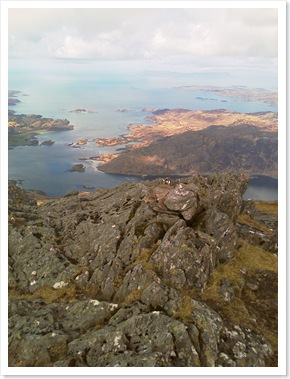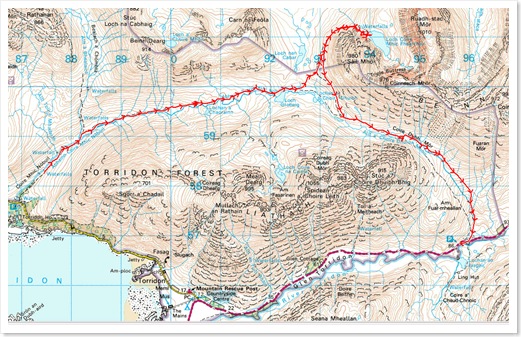
The Ballachulish Horseshoe
Whenever I drive home from Fort William my eyes are always drawn beyond the Ballachulish Bridge to the scimitar ridge of Beinn a’Bheitr above. The curving knife-edge neatly framing the forestry plantations as they plunge down in to Glenahulish below.
Whatever the season, whatever the weather you always notice something different about these mountains. The setting sun glinting from the wet rocky ridges following a late afternoon shower. The Dragon’s tooth menacingly erupting from the primordial swirling mists carpeting the corrie floor. Sweeping, seemingly virgin, snow fields, as crisp as freshly pressed cotton laid out over the ridge and flowing down into the high corries below. What simple delights the crowds miss as they steam across the bridge eyes firmly fixed on the craggier delights of Glencoe. 
Although I have climbed the two Munros of Sgorr Dearg and Sgorr Dhonuill before, I am not so obsessed with bagging that I would refuse to climb a peak again before completing a round. With limited, low level walking over the winter this was the perfect chance to give some underused muscles a workout.
There is no better way to reach the main ridge then climbing from the north-east to the minor top of Sgorr Ban. In fact this is the recommended route in “Scrambles of Lochaber”, describing it as a straightforward scramble with beautiful views. Instead, as I tramped up the boggy ground to the start of the scramble I had to content myself with imagining the Glencoe summits without their cloudy shroud. The way up is always clear with a few interesting moves but little exposure, making it perfect for anyone who has never scrambled before. As I was plodding along, my companions ahead merged in to the grey fog, spectres floating in and out of sight. There was a real feeling of solitude as I was enveloped in the murky silence. The fog thickened on the approach to Sgorr Dhearg, the edge of the cornice barely visible and only a hint of the corrie beyond.
A quick check of compass and map at the summit gave us our bearings to descend towards the col before the stiff climb up to Sgorr Dhonuill. At the col it seemed that we might have to descend to Glenachulish as the way ahead seemed to be blocked by an extensive snowfield. Both ice-axe and crampons had been consigned to the car boot before setting off, deemed to be unnecessary on such a day. Fortunately, the snow was limited and where it needed crossing it was soft enough to walk through or in unexposed areas presenting no particular danger.
Beyond the summit of the second munro we opted for the quicker descent down the “Red Scree Gully” rather than continuing around the ridge. Although steep and unstable in places the gully soon leads to a well engineered path and down into the heart of Forestry Commission land and the tracks leading to the small parking area. A pre-arranged driver to ferry us back to our cars meant we avoided the long trek via St John’s Church to Ballachulish.

![Reblog this post [with Zemanta]](https://i0.wp.com/img.zemanta.com/reblog_e.png)









 By now, with sheets of water draining off the mountainside, we realised that crossing the river on our return would be nearly impossible. Sure enough our way across was blocked by a heaving mass of water ready to knock any foolish walker, trying to ford it, from their feet. At the end of a long day your heart sinks at such an obstacle and the prospect of a long diversion, or even having to retrace your footsteps. Will weary legs carry you further than originally intended? Fortunately by following the east bank of the river, although boggy for much of the way, eventually led tired bodies to a rough path down to the
By now, with sheets of water draining off the mountainside, we realised that crossing the river on our return would be nearly impossible. Sure enough our way across was blocked by a heaving mass of water ready to knock any foolish walker, trying to ford it, from their feet. At the end of a long day your heart sinks at such an obstacle and the prospect of a long diversion, or even having to retrace your footsteps. Will weary legs carry you further than originally intended? Fortunately by following the east bank of the river, although boggy for much of the way, eventually led tired bodies to a rough path down to the 

